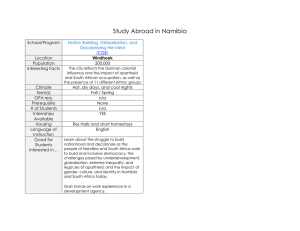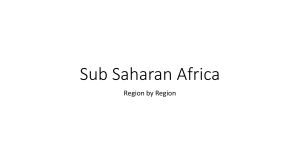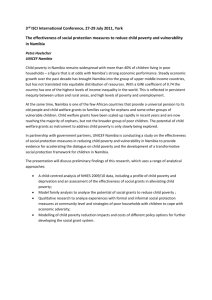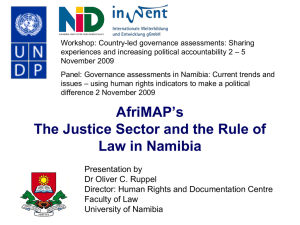Doreen Sioka
advertisement
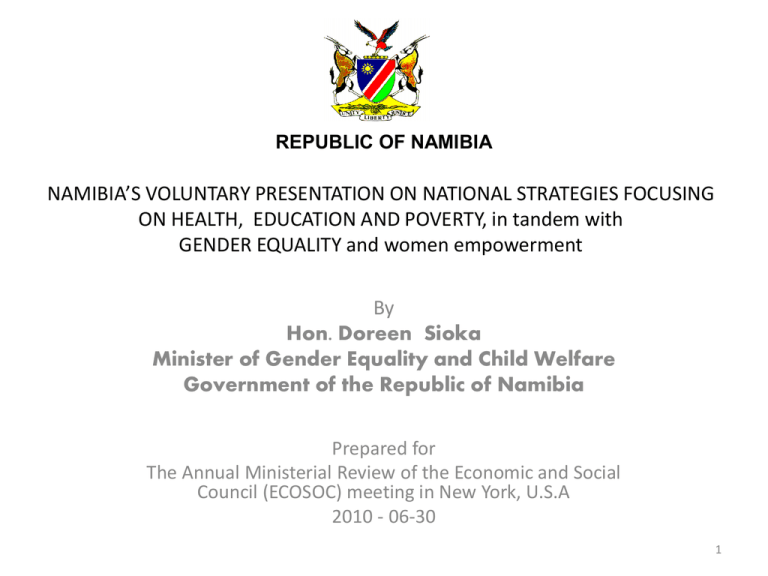
REPUBLIC OF NAMIBIA NAMIBIA’S VOLUNTARY PRESENTATION ON NATIONAL STRATEGIES FOCUSING ON HEALTH, EDUCATION AND POVERTY, in tandem with GENDER EQUALITY and women empowerment By Hon. Doreen Sioka Minister of Gender Equality and Child Welfare Government of the Republic of Namibia Prepared for The Annual Ministerial Review of the Economic and Social Council (ECOSOC) meeting in New York, U.S.A 2010 - 06-30 1 The Presentation: Focus INTRODUCTION Political Framework: • General Overview Economic & Development Planning - Focus • IADGs, MDGs Vision 2030 Objectives The Planning Process • The Key Elements MAIN FOCUS: GENDER and HEALTH, EDUCATION, and P0VERTY 2 Background • This presentation is a response to the UN General Assembly Resolution 61/16 on the “strengthening of the Economic and Social Council” of November 26th, 2006, focusing on sister nations’ shared and exclusive experiences in the implementation of IADGs, MDGs, and OWN NATIONAL developmental goals, in particular strategies used in the processes. • The presentation summarises the main Report which focuses on gender and health; gender and education; and gender and poverty in relation to achieving the IADGs , MDGs, and Namibia’s Vision 2030 objectives. 3 Political Framework Borders: North: East: West: South: Angola and Zambia Zimbabwe and Botswana Atlantic Ocean South Africa Regions: 13, Each headed by a Governor National Parliament : 72 Members National Council: 26 Members H.E. the President, Executive, and Judiciary 4 Political Framework Continues • Attained independence in 1990 • Based on: multi-party democracy separation of powers unitary state with an Independent Electoral Commission 5 Key Features: Population 6 Additional Statistics: • • • • + 2 million people 65+ % rural mostly in the northern part. Rural: Male 47% Female 53% Urban: Male 53% Female 47% 7 Economic & Developmental Planning These factors generally guide national and developmental planning 8 Economic Features: • A thriving mixed economy. • Heavily dependent on mineral extraction and processing of minerals for export. • Rich alluvial diamond deposits makes Namibia a primary source of quality-germs. • World’s 5th largest exporter of uranium, and 4th largest African exporter of non-fuel minerals. • GDP is estimated at N$78 Billion (U$ 10.3 Billion) as per 2009 preliminary figures 9 Other Economic Features • Presents a modern market supported by a traditional subsistence sector. These combine to generate most of the country's wealth. • The majority population is rural, and depends on subsistence agriculture and animal herding. • Boasts +200,000 skilled workers, and a small but well-trained professional and managerial cadre. 10 Vision 2030 and IAGs (Including MDGs) Synergies and Strategies The given information provides the background to Namibia’s strategies to achieve the IADGs, MDGs, and Vision 2030 objectives in the selected areas, Namely: i). Health and Gender. ii). Education and Gender. iii). Poverty and Gender 11 Health and Gender MGDs 4-6 12 Strategies 1. Prioritisation of ‘Primary Health Care’ as the key to achieving objectives on: Child Health Maternal health Reproductive health, and Measures to prevent other infectious diseases. 13 Strategies continue.. 2. Adoption of an Integrated Management of Adolescents and Adults Illness to achieve increased, effective & comprehensive AntiRetro-Viral treatment results by ‘Rapid rolling-out the Anti-retro-viral treatment programme . Implications: budgetary; staff training, and effective information dissemination. 14 Strategies continue.. 3. Research into national health issues and experiences through workshops and conferences. 4. Undertaking Preventive immunisation campaigns’ 5. Upgrading existing infra-structure and constructing new facilities to keep pace with population growth. 15 Strategies continue.. 6. Cultivating and maintaining Cordial DonorHost Relationship. 7. Constant training of new and old personnel. 16 Outcomes 1. Increased accessibility of public health services to women and girl-children. 2. Increased dissemination of information on diseases/illnesses and on what preventive action to take. 3. Sustained donor contribution towards government’s effort to achieve the MDGs. 17 Outcomes continue… 4. At Independence (in 1990) there was only one major hospital, now Namibia has: 1 National Hospital; 3 Intermediate Hospitals; 34 District Hospitals; 44 Health Centre; and 267 Primary Care Clinics. 18 Outcomes continue.. Goals and indicators 1990/1993 Baseline Current Status (2008) 2006 target 2012 target Target/ goal achievable? Children under five, malnourished, stunted, in % of all children under five 28.4 24.2 - 18 Possible Share of women employed in nonagriculture (percent) 39 47 - 50 Likely. Infant mortality rate deaths per 1,000 live births 56.6 49 36 38 Unlikely Under-five mortality rate deaths per 1,000 live births 83.2 69 54 45 Unlikely Share of one-year old children immunized against measles (percent) 75.7 83.8 80 85 Likely 225 449 268 337 Unlikely Reduce child mortality Improve maternal health Maternal mortality rate, deaths per 100,000 live births 19 Outcomes continue.. Goals and indicators 1990/1993 Baseline Current Status (2008) 2006 target 2012 target Target/ goal achievable? Birth attendance by trained health personnel (percent) Use of contraceptives (percent) 68 81 88 95 Likely 23 47 50 56.6 Likely Adolescent birth rate (percent) 22 15 - 13 Likely Ante-natal care coverage (percent) 56 70 - 80 Likely Unmet need for family planning (percent) 24 7 - 6* Likely HIV prevalence, 15 – 19 years (percent) 6 5.1 9 8 Achieved HIV prevalence, 20 – 24 years (percent) 11 14.0 15% 12 Possible People living with HIV, 15 – 49 years (percent) Condom use at the last higher-risk sex, women 15 – 24 years (percent) Condom use at the last higher-risk sex, men 15 – 24 years (percent) - 15.3 - - - 64 45 - - 81 - - Lack of data Lack of data Lack of data HIV/AIDS 20 Outcomes continue.. Goals and indicators 1990/1993 Baseline Current Status (2008) 2006 target 2012 target Target/ goal achievable? - 66 - 75 Likely Proportion of population with advanced HIV infection with access to ARV drugs (per cent) Tuberculosis, Malaria TB cases detected per 100,000 population 656 765 - <300 Possible Likely TB cases treated successfully (percent) 64 76 75 85 Likely Incidence of malaria per 1000 population 207 48 - Halt and begin to reverse Achieved 21 Outcomes continue.. Goals and indicators Protected areas Communal conservancies Freehold land conservancies Community forestry (ha) Percent households with access to safe drinking water Urban Rural Percent households with access to basic sanitation Urban Rural Official development assistance to (per capita $) 1990/199 3 Baseline Current Status (2008) 2006 target 2012 target Target/ goal achievable? 14 0 5 0.0 18 14 6 460000 15 11 9 300000 20 15 10 2.5 mio Likely Likely Unlikely Possible 99 74 97 80 95 80 100 87 Possible Likely 86 14 80 58 14 88 (2006) 50 - 98 65 90 Unlikely Unlikely Likely * NDP3, **1993/1994 22 Outcomes continue.. Internet users, per 100 population - 4.8 - - Lack of data Cell phone subscribers, per 100 population, 16 years and older Telephone lines, per 100 households - 49 - - Lack of data - 34.6 - - Lack of data 23 Challenges • Financially and materially sustain the effectiveness of the programmes on: primary health care - - Child mortality - Maternal Mortality - Reproductive health, and - Measures to prevent other infectious diseases. immunization HIV/AIDS nutrition poverty, and others 24 Education and Gender MDG 2 25 The Strategies The strategies are based on government's commitment to achieve comprehensive capacity building objectives in line with the objectives of Vision 2030 which seek to see Namibia become ‘A prosperous and industrialized society developed by own human resources enjoying peace, harmony and political stability’. 26 Rationale Strategies on Education: NMDG2 Historically women have been the most disadvantaged educationally. Government sought to rectify that through strategies that can have long term developmental empowerment of women and make them economically independent. 27 Strategy One 1. Education and Training Sector Improvement Programme (ETSIP). Objective: To strategically guide the provision of public education and training in order to ensure achievement of Vision 2030 objectives with an intentional bias to empower women. 28 Accompanying Policy Instruments Education for All Policy – with focus on Primary & Secondary Schools: Net enrollment Youth literacy (15-24 years) Survival rate at Grade 8 Access to tertiary Institutions, particularly by women. 29 Accompanying Instruments Education Sector Policy for the Prevention and Management of Learner Pregnancy Goal: To promote the continued education of pregnant learners and to ensure equal treatment of female and male learners. 30 Strategy Two 2. Establishment of Namibia College of Open Learning (NAMCOL). Goal: Provision of additional opportunities in the event of failure the first, or being deprived the freedom to rejoin the mainstream after dropping out for various reasons, which often happened to girls who became pregnant, or forced out of school by cultural practices. 31 Strategy Three 3. Re-training and Continued Upgrading of Teachers Qualification Combined with Introduction of Attractive Incentives to entice qualified teachers to take up positions in the Rural Areas, & increasing the quantity & quality of teaching material. • Goals: Improve teaching skills . • Improve educational equity nationally. • Ensure value for the huge budget allocated for national capacity building through education. 32 Outcomes Goals and indicators 1990/1993 Baseline Current Status (2008) 2006 target 2012 target Target/ goal achievable? Achieve universal primary education Net primary school enrolment (percent) 89 92.3 95 99.1 Unlikely Youth literacy rate (percent) 88 93 94 100* Unlikely Survival rate grade 5 (percent) 70 94 95 99.2 Possible Survival rate grade 8 (percent) 59 81 - 80.2 Achieved Primary education 102 98 100+ 100 Likely Secondary education 124 117 100+ 100 Achieved Tertiary education 175 88 100+ 100 Possible Literacy 106 103 100 100 Achieved Share of women employed in nonagriculture (percent) 39 47 - 50 Likely. Share of seats held by women in parliament (percent) 6.9 26.9 26.9 50 Possible Females per 100 males in 33 Challenges • Stereotypes, specially it terms of education for women. • Raising passing percentages particularly at Grade 10 and Grade 12 levels given the 30% of the national budget allocated for education annually. • Making available adequate infra-structure and well trained teachers at all levels. • Shortage of teaching and learning material. 34 Poverty and Gender MDG 1 35 Strategies Rationale for MDG 1 in Namibia: Poor population: 28% Severely poor: 4% Rural population: +65% Rural women: 53% Vision 2030 seeks to see the country developed. Equal rights & the rights for women in all human activities, in particular, Economic Endeavours. 36 Strategy One 1. Creation of an enabling environment in which women can have access to economic opportunities and autonomy across the board. Instruments: i. Policies for financial institutions. ii. Intensification of job creation programmes. iii. Improvement of business climate for women. 37 Instruments Continue iv. Affirmative Action, Land Resettlement, and Equal Opportunity policies Implementation: - Arms of government. - Private Institutions’ voluntary compliance with government policies. - Private individuals. 38 Strategy Two 2. Establishment of Koshi Yomuti [Definition: Banking under a tree’]. ‘A financial outfit established to assist women, in particular rural women involved with small business enterprises by offering banking and credit services’. It was modeled after SUSU of West Africa. 39 Koshi Yomuti: Modus Operandi • Governed by the Division of Cooperative Development in the Ministry of Water and Forestry. • Catered for the rural poor, in particular women (92% women). • Products: Loans - Servings Training 40 Modus Operandi Continues • Provided ‘one on one’ consultation on how to run small businesses. • Provided 5 training sessions to new clients. • Advise clients to serve through the post office. • Used mobile facilities (bicycles/motorbikes). • Offered differentiated loans to individuals and groups. 41 Outcomes • Many women benefited. • Helped to create relative success in reducing rural poverty. • Its success convinced Government to provide support in: - Credit for working capital or investment - Business planning to get a loan - Provide information on business. 42 Outcomes continue.. Goals and indicators Poor HH (including severely poor HH), % of all HH Severely poor HH, % of all HH Unemployment rate, broad concept, nationwide in percent 1990/1993 Baseline Current Status (2008) 2006 target 2012 target Target/ goal achievable? 38** 28 28 19* Possible 9** 34. 5 4 36.7 4 33.8 3.5* 33.3 Achieved Possible - 2.6 Possible 4.7 4.3 2.6 -3.2 5.0 6.5 0.58 (1997) Employment growth, % p.a., average in period GDP growth rate p.a., average 3.6 percent in period Gini-coefficient 0.701 0.6 Possible Likely 43 Challenges • Economic reclassification of Namibia as an ‘Upper Middle class’ country while poverty, particularly among women, is still rampart. • It is difficult to convince major financial institutions to provide –with minimum if not without collateralaccess to rural women intending to undertake microfinance businesses. • It is not easy create enough jobs to absorb High School leavers and graduates from tertiary Institutions yearly. 44 Challenges under poverty continue • How to establish a cross-cutting national budget on gender that can serve to enhance effective articulation of gender issues and requirements at different levels in all arms of government. 45 General Challenges 46 General Challenges • Categorization of Namibia as an “uppermiddle-income-economy” • Costly access to international finance capital – creating a serious impediment to her developmental agenda. • Dwindling international support 47
